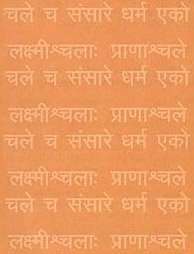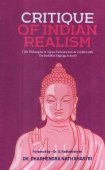Samavaya, Samavāya, Samāvaya, Samāvāya: 25 definitions
Introduction:
Samavaya means something in Hinduism, Sanskrit, Jainism, Prakrit, Buddhism, Pali, Marathi, Hindi. If you want to know the exact meaning, history, etymology or English translation of this term then check out the descriptions on this page. Add your comment or reference to a book if you want to contribute to this summary article.
Alternative spellings of this word include Samvay.
In Hinduism
Vaisheshika (school of philosophy)
Source: Wisdom Library: VaiśeṣikaSamavāya (समवाय, “inherence”) is one of the seven accepted categories of padārtha (“metaphysical correlate”), according to the Vaiśeṣika-sūtras. These padārthas represent everything that exists which can be cognized and named. Together with their subdivisions, they attempt to explain the nature of the universe and the existence of living beings.
Source: Wikipedia: VaisheshikaSamavāya (समवाय, “inherence”): Kaṇāda defined samavāya as the relation between the cause and the effect (according to the Vaiśeṣika school). Praśastapāda defined it as the relationship existing between the substances that are inseparable, standing to one another in the relation of the container and the contained. The relation of samavāya is not perceivable but only inferable from the inseparable connection of the substances.

Vaisheshika (वैशेषिक, vaiśeṣika) refers to a school of orthodox Hindu philosophy (astika), drawing its subject-matter from the Upanishads. Vaisheshika deals with subjects such as logic, epistemology, philosophy and expounds concepts similar to Buddhism in nature
Ayurveda (science of life)
Source: Wisdom Library: Āyurveda and botanySamavāya (समवाय, “inherence”):—One of the six padārtha (or ‘basic categories’) which should be known to every Physician if he wants to understand the science of life.
Source: Google Books: Essentials of AyurvedaSamavāya (समवाय) is the constant relation of inherence as exists between dravya and guṇa-karma. Dravya cannot remain without these after a moment of its emergence.
Source: gurumukhi.ru: Ayurveda glossary of termsSamavāya (समवाय):—[samavāyaḥ] Coexistance / concomitant relation; the eternal and inseparable relationship which subsist between earth and other proto-element and their qualities.

Āyurveda (आयुर्वेद, ayurveda) is a branch of Indian science dealing with medicine, herbalism, taxology, anatomy, surgery, alchemy and related topics. Traditional practice of Āyurveda in ancient India dates back to at least the first millenium BC. Literature is commonly written in Sanskrit using various poetic metres.
Vyakarana (Sanskrit grammar)
Source: Wikisource: A dictionary of Sanskrit grammarSamavāya (समवाय).—(I) combination as contrasted with व्यवाय (vyavāya) disjunction or separation; (2) the enumeration of the letters of the alphabet in a particular order so as to facilitate their combination, technically termed प्रत्याहार (pratyāhāra); cf. वृतिसमवायार्थ उपदेशः । का पुनर्वृत्तिः । शास्त्रप्रवृत्तिः । अथ कः समवायः । वर्णानामानुपूर्व्येण संनिवेशः । (vṛtisamavāyārtha upadeśaḥ | kā punarvṛttiḥ | śāstrapravṛttiḥ | atha kaḥ samavāyaḥ | varṇānāmānupūrvyeṇa saṃniveśaḥ |) M. Bh. Ahnika । (|) Vart. 15. cf. also समवायो वर्णगतः क्रमविशेषः । (samavāyo varṇagataḥ kramaviśeṣaḥ |) Uddyota on the Bhasya mentioned above; (3) contact; cf रक्तै रागः समवाये स्वराणाम् (raktai rāgaḥ samavāye svarāṇām) R. Pr. XIV.24.

Vyakarana (व्याकरण, vyākaraṇa) refers to Sanskrit grammar and represents one of the six additional sciences (vedanga) to be studied along with the Vedas. Vyakarana concerns itself with the rules of Sanskrit grammar and linguistic analysis in order to establish the correct context of words and sentences.
Nyaya (school of philosophy)
Source: Shodhganga: A study of Nyāya-vaiśeṣika categoriesSamavāya (समवाय, “inherence”) refers to one of the six divisions of Sannikarṣa (“sense object contact”), according to the 17th century Tarkasaṃgraha. The ordinary perception (laukika), one of the two types of pratyakṣa (perception), is caused by ordinary sannikarṣa or sense object contact. Inherent union (samavāya) is the contact in the perception of word by the organ of hearing as the organ of hearing is the ether in the cavity of the ear in as much as sound is the quality of ether and the quality and the qualified are inherently united.

Nyaya (न्याय, nyaya) refers to a school of Hindu philosophy (astika), drawing its subject-matter from the Upanishads. The Nyaya philosophy is known for its theories on logic, methodology and epistemology, however, it is closely related with Vaisheshika in terms of metaphysics.
Shaivism (Shaiva philosophy)
Source: Brill: Śaivism and the Tantric Traditions (philosophy)Samavāya (समवाय) refers to “inherence (of the whole in its parts)”, according to the Īśvarapratyabhijñāvimarśinī 1.181.—Accordingly, “As for the additional arguments refuting [the existence of the external object], they are: the impossibility of the existence of a whole (avayavin) [in its parts]; the fact that the inherence (samavāya) [of the whole in its parts] is not established; the fact that the [external object must] possess some contradictory properties, such as movement and the absence of movement, being covered and being uncovered, being colored and being colourless, being differentiated into parts according to [the six] directions (digbhāgabheda), etc.”.

Shaiva (शैव, śaiva) or Shaivism (śaivism) represents a tradition of Hinduism worshiping Shiva as the supreme being. Closely related to Shaktism, Shaiva literature includes a range of scriptures, including Tantras, while the root of this tradition may be traced back to the ancient Vedas.
In Jainism
Jain philosophy
Source: archive.org: Anekanta Jaya Pataka of Haribhadra SuriSamavāya (समवाय) refers to the “cause of the experience”, as occurring in the Anekāntajayapatākā-prakaraṇa, a Śvetāmbara Jain philosophical work written by Haribhadra Sūri.—[Cf. Vol. I, P. 94, l. 16]—Samavāya is here defined as the cause of the experience of ādhārya say a pata residing in an ādhāra say tantus, the ādhārya and ādhāra which are proved to be inherent and inseparable samavāya is looked upon by the Vaiśeṣikas as residing in dravya, guṇa, karman, sāmānya and viśeṣa, and it is called vṛtti, too. It is further said to be one, permanent, all-pervading and incorporeal. Samavāyavāda is refuted here and in Dhammasaṅgahani [Dhammasaṅghanī ?].
-
Languages of India and abroad
Pali-English dictionary
Source: BuddhaSasana: Concise Pali-English Dictionarysamavāya : (m.) combination; coming together.
Source: Sutta: The Pali Text Society's Pali-English DictionarySamavāya, (m.) coming together, combination S. IV, 68; Miln. 376; DhsA. 57, 196; PvA. 104; VvA. 20, 55. samavāyena in common VvA. 336; khaṇa-s° a momentary meeting J. I, 381. (Page 684)
— or —
Samāvaya, =samavāya, closely united J. VI, 475 (in verse). (Page 686)
— or —
Samavaya, annihilation, termination (?) see samaya (cpd.) & saṭha. (Page 684)

Pali is the language of the Tipiṭaka, which is the sacred canon of Theravāda Buddhism and contains much of the Buddha’s speech. Closeley related to Sanskrit, both languages are used interchangeably between religions.
Marathi-English dictionary
Source: DDSA: The Molesworth Marathi and English Dictionarysamavaya (समवय) [or समवयस्क, samavayaska].—a (S) pop. samavayī a Of the same age, coëtaneous.
--- OR ---
samavāya (समवाय).—m S Assemblage, collection, multitude, accumulation, a number or an aggregate quantity. 2 In logic. One of the categories enumerated under padārtha. Intimate and constant relation or connection (as of the material with the article made of it, as of the several species with the including genus, as of all the parts with the whole). Also samavāyasambandha.
Source: DDSA: The Aryabhusan school dictionary, Marathi-Englishsamavaya (समवय) [-vayaska-vayī, -वयस्क-वयी].—a Of the same age, coetaneous.
--- OR ---
samavāya (समवाय).—m Assemblage, collection.
Marathi is an Indo-European language having over 70 million native speakers people in (predominantly) Maharashtra India. Marathi, like many other Indo-Aryan languages, evolved from early forms of Prakrit, which itself is a subset of Sanskrit, one of the most ancient languages of the world.
Sanskrit dictionary
Source: DDSA: The practical Sanskrit-English dictionarySamavāya (समवाय).—
1) Combination, union, conjunction, aggregate, collection; तेषां समवाये एकदेशकालकतृत्वे (teṣāṃ samavāye ekadeśakālakatṛtve) ... एकतन्त्रत्वं भवति (ekatantratvaṃ bhavati) ŚB. on MS.12.1.1; सर्वाविनयानामेकैकमप्येषामायतनं किमुत समवायः (sarvāvinayānāmekaikamapyeṣāmāyatanaṃ kimuta samavāyaḥ) K.; बहूनामप्यसाराणां समवायो हि दुर्जयः (bahūnāmapyasārāṇāṃ samavāyo hi durjayaḥ) Pañcatantra (Bombay) 1. 331; Bhāgavata 6.9.34.
2) A number, multitude, heap.
3) Close connection, cohesion; कर्तृदेशकालानामचोदनं प्रयोगे नित्यसमवायात् (kartṛdeśakālānāmacodanaṃ prayoge nityasamavāyāt) MS.4.2.23.
4) (In Vaiś. phil.) Intimate union, constant and inseparable connection, inseparable inherence or existence of one thing in another, one of the seven categories of the Vaiśeṣikas; उक्तं समवाये पारदौर्बल्यम् (uktaṃ samavāye pāradaurbalyam) MS.8.4.17; नित्यसंबन्धः समवायः (nityasaṃbandhaḥ samavāyaḥ) Tarka K.
5) Conjunction of heavenly bodies; समालोक्यैकतामेव शशिनो भास्करस्य च । समवायं तु तं रौद्रं दृष्ट्वा शक्रोऽन्वचिन्तयत् (samālokyaikatāmeva śaśino bhāskarasya ca | samavāyaṃ tu taṃ raudraṃ dṛṣṭvā śakro'nvacintayat) || Mahābhārata (Bombay) 3. 224.16.
Derivable forms: samavāyaḥ (समवायः).
--- OR ---
Samāvāya (समावाय).—
1) Association, connection.
2) Inseparable connection; see समवाय (samavāya).
3) Aggregation.
4) A multitude, number, heap.
5) Conjunction (of heavenly bodies).
Derivable forms: samāvāyaḥ (समावायः).
Source: Cologne Digital Sanskrit Dictionaries: Shabda-Sagara Sanskrit-English DictionarySamavāya (समवाय).—m.
(-yaḥ) 1. Multitude, assemblage, collection, aggregate, quantity. 2. One of the categories or Padart'has of logic, intimate and constant relation, as of yarn and the cloth made of it. 3. Connection of species in a genus, or parts of a whole. E. sam and ava before ay to go, aff. ghañ .
--- OR ---
Samāvāya (समावाय).—m.
(-yaḥ) 1. A multitude, a number, a heap or quantity. 2. Association. 3. Integral or inseparable aggregation. E. sam and āṅ implying aggregation, ay to go, aff. ghañ .
Source: Cologne Digital Sanskrit Dictionaries: Benfey Sanskrit-English DictionarySamavāya (समवाय).—i. e. sam-ava-i + a, m. 1. Multitude, [Pañcatantra] 130, 7; aggregate; meeting, [Daśakumāracarita] in
--- OR ---
Samāvāya (समावाय).—i. e. sam-ā-ava -i + a, m. 1. Integral aggregation, totality, [Bhāgavata-Purāṇa, (ed. Burnouf.)] 2, 8, 14. 2. Association. 3. A multitude.
Source: Cologne Digital Sanskrit Dictionaries: Cappeller Sanskrit-English DictionarySamavāya (समवाय).—[masculine] meeting with, joining ([genetive] or —°); congress, assembly; union, connection, mixture, aggregate; intimate cohesion, inherence, adj. yin (ph.).
--- OR ---
Samāvāya (समावाय).—[masculine] = samavāya.
Source: Cologne Digital Sanskrit Dictionaries: Monier-Williams Sanskrit-English Dictionary1) Samavāya (समवाय):—[=sam-avāya] [from sam-ave] m. coming or meeting together, contact, concourse, congress, assemblage, collection, crowd, aggregate (ena or āt, ‘in combination’; yaṃ-√kṛ, ‘to meet, combine, flock together’), [Gṛhya-sūtra; Gautama-dharma-śāstra; Manu-smṛti] etc.
2) [v.s. ...] conjunction (of heavenly bodies), [Mahābhārata; Varāha-mihira’s Bṛhat-saṃhitā]
3) [v.s. ...] collision, [???; Gautama-dharma-śāstra; Sarvadarśana-saṃgraha]
4) [v.s. ...] (in [philosophy]) perpetual co-inherence, inner or intimate relation, constant and intimate union, inseparable concomitance (= nitya-sambandha, the sixth Padārtha or category of the Vaiśeṣikas, expressing relation which exists between a substance and its qualities, between a whole and its parts e.g. between cloth and the yarn composing it, between a genus and its individuals etc.), [Kapila; Jaimini; Indian Wisdom, by Sir M. Monier-Williams 66; 69]
5) [v.s. ...] course, duration (e, with [genitive case], ‘during’), [Mahābhārata i, 556]
6) Samāvāya (समावाय):—[=sam-āvāya] m. (m.[case] for sam-av q.v. under sam-avāp. 1157), [Mahābhārata; Rāmāyaṇa; Bhāgavata-purāṇa]
Source: Cologne Digital Sanskrit Dictionaries: Yates Sanskrit-English Dictionary1) Samavāya (समवाय):—(yaḥ) 1. m. Co-ordination; multitude, quantity; a category.
2) Samāvāya (समावाय):—[samā+vāya] (yaḥ) 1. m. A multitude, conglomeration, association.
Source: DDSA: Paia-sadda-mahannavo; a comprehensive Prakrit Hindi dictionary (S)Samavāya (समवाय) in the Sanskrit language is related to the Prakrit word: Samavāya.
[Sanskrit to German]
Sanskrit, also spelled संस्कृतम् (saṃskṛtam), is an ancient language of India commonly seen as the grandmother of the Indo-European language family (even English!). Closely allied with Prakrit and Pali, Sanskrit is more exhaustive in both grammar and terms and has the most extensive collection of literature in the world, greatly surpassing its sister-languages Greek and Latin.
Hindi dictionary
Source: DDSA: A practical Hindi-English dictionarySamavāya (समवाय) [Also spelled samvay]:—(nm) collection, company; concourse; concomitance; —[saṃbaṃdha] inseparable relation, intimate and constant connection.
...
Prakrit-English dictionary
Source: DDSA: Paia-sadda-mahannavo; a comprehensive Prakrit Hindi dictionarySamavāya (समवाय) in the Prakrit language is related to the Sanskrit word: Samavāya.
Prakrit is an ancient language closely associated with both Pali and Sanskrit. Jain literature is often composed in this language or sub-dialects, such as the Agamas and their commentaries which are written in Ardhamagadhi and Maharashtri Prakrit. The earliest extant texts can be dated to as early as the 4th century BCE although core portions might be older.
Kannada-English dictionary
Source: Alar: Kannada-English corpusSamavaya (ಸಮವಯ):—[noun] equality of age.
--- OR ---
Samavāya (ಸಮವಾಯ):—
1) [noun] the state of being united, joined together; union.
2) [noun] an inseparable association.
3) [noun] a throng of people; a multitude.
4) [noun] (phil.) the sixth of the seven categories expressing the relation which exists between a substance and its qualities, betweeen a whole and its parts.
Kannada is a Dravidian language (as opposed to the Indo-European language family) mainly spoken in the southwestern region of India.
See also (Relevant definitions)
Partial matches: Vaya, Sam, Avaya, Cama, Sama.
Starts with: Camavayacu, Samavayaja, Samavayakhandana, Samavayam, Samavayana, Samavayanga, Samavayapramanavadartha, Samavayasa, Samavayasambandha, Samavayask, Samavayaska, Samavayaske, Samavayatas, Samavayatva, Samavayavada.
Ends with: Abhisamavaya, Gurusamavaya, Mithahsamavaya, Nigamitasamavaya, Purushasamavaya, Samavetasamavaya, Samyuktasamavaya, Samyuktasamavetasamavaya, Sarvasamavaya, Tantrisamavaya, Vrittisamavaya.
Full-text (+56): Samavayasambandha, Purushasamavaya, Samavayam, Samavayika, Samavayatva, Shadbhavavadin, Samavayin, Samavayavada, Samavayakhandana, Samavayapramanavadartha, Padartha, Samavayatas, Samavayikarana, Samavayana, Samyuktasamavetasamavaya, Samyuktasamavaya, Shatapadartha, Sannikarsha, Samavapa, Mithahsamaya.
Relevant text
Search found 54 books and stories containing Samavaya, Sam-avaya, Sam-avāya, Sam-āvāya, Sama-vaya, Samavāya, Samāvaya, Samāvāya, Samayaya, Samayāya; (plurals include: Samavayas, avayas, avāyas, āvāyas, vayas, Samavāyas, Samāvayas, Samāvāyas, Samayayas, Samayāyas). You can also click to the full overview containing English textual excerpts. Below are direct links for the most relevant articles:
Nyaya-Vaisheshika categories (Study) (by Diptimani Goswami)
Samavāya < [Chapter 6 - Nyāya-Vaiśeṣika theory of Relation]
Nature of Abhāva < [Chapter 7 - Abhāva (Non-existence)]
Padarthadharmasamgraha and Nyayakandali (by Ganganatha Jha)
Text 9 < [Chapter 2 - Enumeration and Classification of Categories]
Text 157 < [Chapter 9 - On Samavāya (Inherence)]
Text 161 < [Chapter 9 - On Samavāya (Inherence)]
Philosophy of Charaka-samhita (by Asokan. G)
Inherence (samavāya) [in Charaka philosophy] < [Chapter 2 - Fundamental Categories]
Fundamental Categories (padārtha or tattva) [in Charaka philosophy] < [Chapter 2 - Fundamental Categories]
Dialectical terms [in Charaka philosophy] < [Chapter 7 - Logic and Dialectical Speculations]
Vakyapadiya of Bhartrihari (by K. A. Subramania Iyer)
Verse 3.1.15 < [Book 3 - Pada-kāṇḍa (1): Jāti-samuddeśa (On the Universal)]
Verse 3.3.31 < [Book 3 - Pada-kāṇḍa (3): Sambandha-samuddeśa (On Relation)]
Verse 3.3.19 < [Book 3 - Pada-kāṇḍa (3): Sambandha-samuddeśa (On Relation)]
Brahma Sutras (Shankara Bhashya) (by Swami Vireshwarananda)
Chapter II, Section II, Adhikarana III < [Section II]
Reverberations of Dharmakirti’s Philosophy (by Birgit Kellner)
Related products

